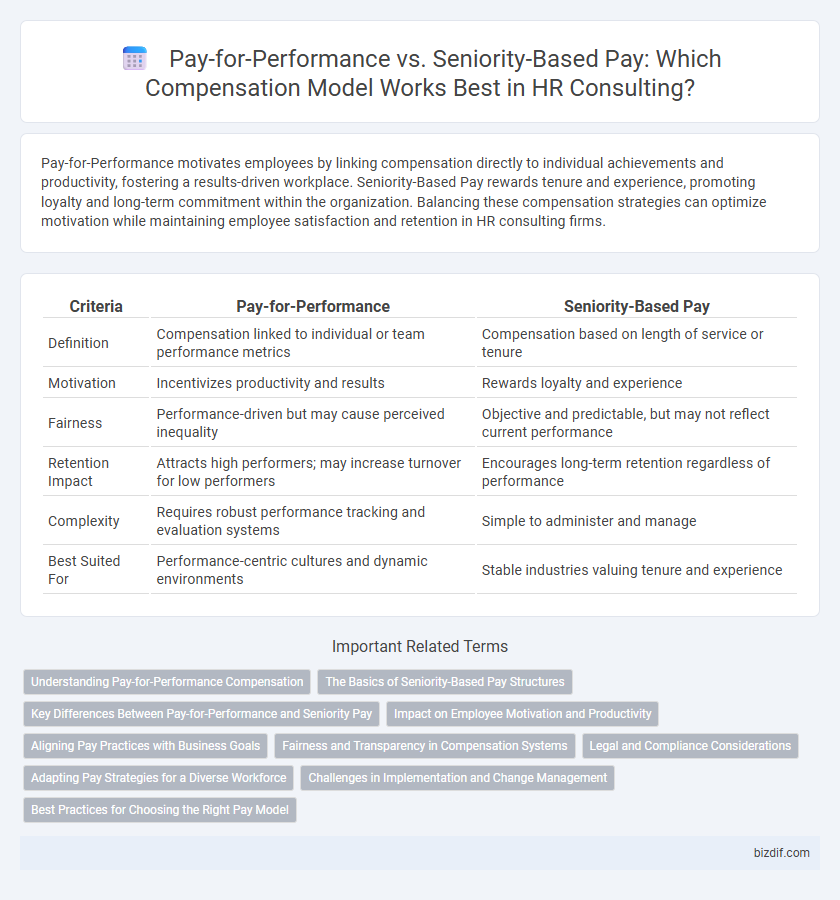Pay-for-Performance motivates employees by linking compensation directly to individual achievements and productivity, fostering a results-driven workplace. Seniority-Based Pay rewards tenure and experience, promoting loyalty and long-term commitment within the organization. Balancing these compensation strategies can optimize motivation while maintaining employee satisfaction and retention in HR consulting firms.
Table of Comparison
| Criteria | Pay-for-Performance | Seniority-Based Pay |
|---|---|---|
| Definition | Compensation linked to individual or team performance metrics | Compensation based on length of service or tenure |
| Motivation | Incentivizes productivity and results | Rewards loyalty and experience |
| Fairness | Performance-driven but may cause perceived inequality | Objective and predictable, but may not reflect current performance |
| Retention Impact | Attracts high performers; may increase turnover for low performers | Encourages long-term retention regardless of performance |
| Complexity | Requires robust performance tracking and evaluation systems | Simple to administer and manage |
| Best Suited For | Performance-centric cultures and dynamic environments | Stable industries valuing tenure and experience |
Understanding Pay-for-Performance Compensation
Pay-for-performance compensation directly links employee earnings to their individual achievements and contributions, incentivizing productivity and goal alignment. This model contrasts with seniority-based pay, where salary increments primarily depend on tenure, potentially overlooking performance variations. Understanding pay-for-performance enables organizations to foster a meritocratic culture, drive motivation, and enhance overall business results through targeted reward strategies.
The Basics of Seniority-Based Pay Structures
Seniority-based pay structures reward employees primarily based on their length of service within an organization, ensuring predictable salary progression tied to tenure. This approach simplifies payroll management and fosters loyalty by recognizing experience and long-term commitment. Organizations using seniority-based pay often prioritize stability and employee retention over direct performance metrics.
Key Differences Between Pay-for-Performance and Seniority Pay
Pay-for-performance compensates employees based on individual achievements, directly linking salary to measurable results such as sales targets or project completions. Seniority-based pay rewards longevity and experience, providing incremental raises and benefits according to tenure rather than performance metrics. This fundamental difference impacts employee motivation, with pay-for-performance encouraging continual high achievement, while seniority pay emphasizes loyalty and stability within the organization.
Impact on Employee Motivation and Productivity
Pay-for-performance systems drive higher employee motivation and productivity by directly linking compensation to individual achievements, fostering a results-oriented culture. Seniority-based pay provides stability and rewards loyalty, but may limit motivation for high performers due to less differentiation in rewards. Businesses seeking to maximize workforce efficiency often favor performance-based incentives to encourage continuous improvement and goal alignment.
Aligning Pay Practices with Business Goals
Pay-for-Performance systems directly link employee compensation to individual and company outcomes, driving productivity and innovation that align with strategic business objectives. Seniority-Based Pay emphasizes tenure, promoting employee retention and loyalty but may risk misalignment with evolving organizational goals and performance standards. Balancing these approaches ensures compensation strategies effectively motivate workforce behavior while supporting long-term business growth and competitive advantage.
Fairness and Transparency in Compensation Systems
Pay-for-Performance compensation systems enhance fairness by directly linking employee rewards to measurable outcomes and clear performance metrics, ensuring transparency in how pay decisions are made. Seniority-Based Pay offers predictability but may obscure equitable recognition of individual contributions, potentially reducing perceived fairness among high performers. Implementing transparent evaluation criteria and communication mechanisms is crucial for fostering trust and motivation in either pay structure.
Legal and Compliance Considerations
Pay-for-performance systems require strict adherence to anti-discrimination laws such as the Equal Pay Act and Title VII to ensure fair evaluation criteria and unbiased reward distribution. Seniority-based pay structures must comply with the Age Discrimination in Employment Act (ADEA), preventing unfair disadvantages against younger employees while honoring tenure. Employers need comprehensive documentation and periodic audits to maintain compliance and mitigate legal risks in both compensation models.
Adapting Pay Strategies for a Diverse Workforce
Pay-for-performance systems align compensation with employee contributions, driving motivation and productivity in diverse teams by rewarding measurable results. Seniority-based pay recognizes tenure and experience, providing stability but potentially limiting incentives for continuous improvement among heterogeneous groups. Balancing these models allows HR consultants to tailor pay strategies that accommodate varying employee needs, fostering equity and engagement across a multifaceted workforce.
Challenges in Implementation and Change Management
Pay-for-Performance systems face challenges such as aligning clear performance metrics with organizational goals and overcoming employee resistance to perceived unfairness or bias. Seniority-Based Pay structures often struggle with maintaining motivation among high performers while managing expectations of long-tenured employees. Effective change management requires transparent communication, ongoing training, and stakeholder engagement to facilitate cultural shifts and mitigate pushback during the transition.
Best Practices for Choosing the Right Pay Model
Choosing the right pay model in HR consulting requires evaluating organizational goals, industry standards, and employee performance metrics. Pay-for-performance aligns compensation with individual or team achievements, driving productivity and motivation, while seniority-based pay rewards loyalty and tenure, fostering long-term retention. Best practices involve conducting market analysis, assessing workforce demographics, and implementing transparent communication strategies to ensure alignment between compensation models and business objectives.
Pay-for-Performance vs Seniority-Based Pay Infographic

 bizdif.com
bizdif.com